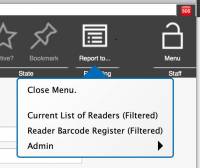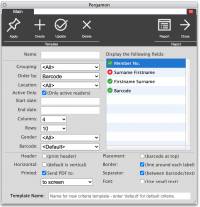This is an old revision of the document!
Table of Contents
Mystic Help
Reports: Criteria Dialog
Within Mystic there are two general ways of creating reports - Quick Reporting, and the more comprehensive Dynamic Reporting system.
Quick Reporting
 The Quick Reporting system is the more accessible and probably the most commonly used way of creating reports. The Quick Reporting system comprises of a range of pre-set reports which may take one or two criteria fields automatically from a particular location where the report can be used.
The Quick Reporting system is the more accessible and probably the most commonly used way of creating reports. The Quick Reporting system comprises of a range of pre-set reports which may take one or two criteria fields automatically from a particular location where the report can be used.
The same report can be accessed from several different locations as long as the criteria on which it depends is available in that dialog of application location.
In order to start a Quick Report, select the [Report to…] toolbar icon to display all of the Quick Reports available in that location. Simply select the required report from the menu to start the report off and send it to either the screen, an attached printer, or in the case of more modern operating systems, to a file.
Remember that only Quick Reports that can be fed criteria from the dialog are ever displayed at one time. By selecting a particular record in that dialog (e.g. selecting a Reader from the list in the Reader Manager), more criteria information becomes available and the Quick Reports menu will be able to display more options.
Dynamic Reporting
The Dynamic Reporting system is far more comprehensive and is not dependant on a particular parent dialog or location. The Dynamic Reports are only accessible from the main [Staff Menu] > [Reports] menu. Dynamic Reports allow you to not only enter a range of different criteria, but also select the fields that you want to be included in the final output.
 Most Dynamic Reports follow a similar format - each report consists of a two stage process: selection of reports criteria and required fields, and production of the report itself either to printer and/or a file.
Most Dynamic Reports follow a similar format - each report consists of a two stage process: selection of reports criteria and required fields, and production of the report itself either to printer and/or a file.
The first stage is performed via a reports criteria dialog. Because each report is designed to produce reports based upon a different Mystic area, the criteria dialog may be slightly different between each report. In most cases however, each criteria dialog can be sub-divided into three general areas:
Criteria fields
A set of criteria fields are presented down the left hand side of each report dialog. These fields provide the ability to enter search parameters to narrow down the results that will be displayed in the report. In most cases, these fields will be free-text entry fields that can also contain wild-cards, drop-down lists and boolean checkboxes.
Display Fields
A list of fields accessible to the report is presented in a listbox down the right hand side of the dialog. Each field is accompanied by a checkbox. In order to include a field in the final report, ensure that the field is checked. Similarly, in order to remove a field from the final report ensure that the field is un-checked.
Note: At this time, the online reporting system does not allow reordering of fields.
If you want to save changes to the displayed configuration long term, consider using the Template system, link below.
Report Command Area
The bottom of each report dialog contains a series of additional configuration checkboxes which determine where the report is sent, and any global configurations that affect how it will be created.
Report Toolbar
The bulk of the reports toolbar is mainly concerned with the management of report templates (see link below).
In order to start the report however once configured, click the [Report] toolbar icon to the right of the toolbar.
To close the report dialog, either click the [X] in the frame of the dialog (if provided by your browser) or click the [Close] toolbar icon at the far right of the toolbar.
Additional Help:
